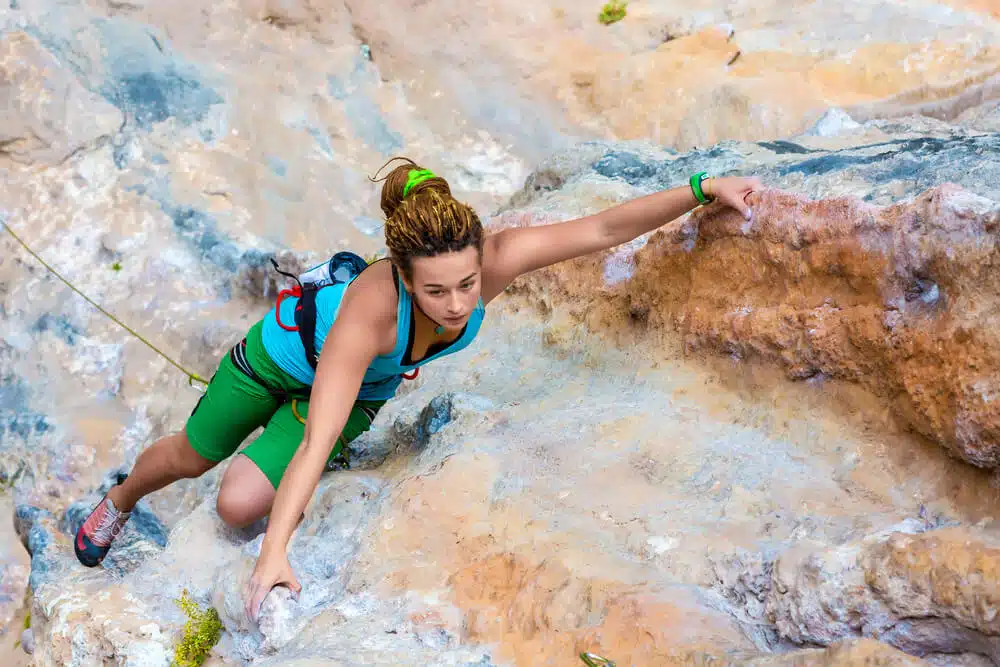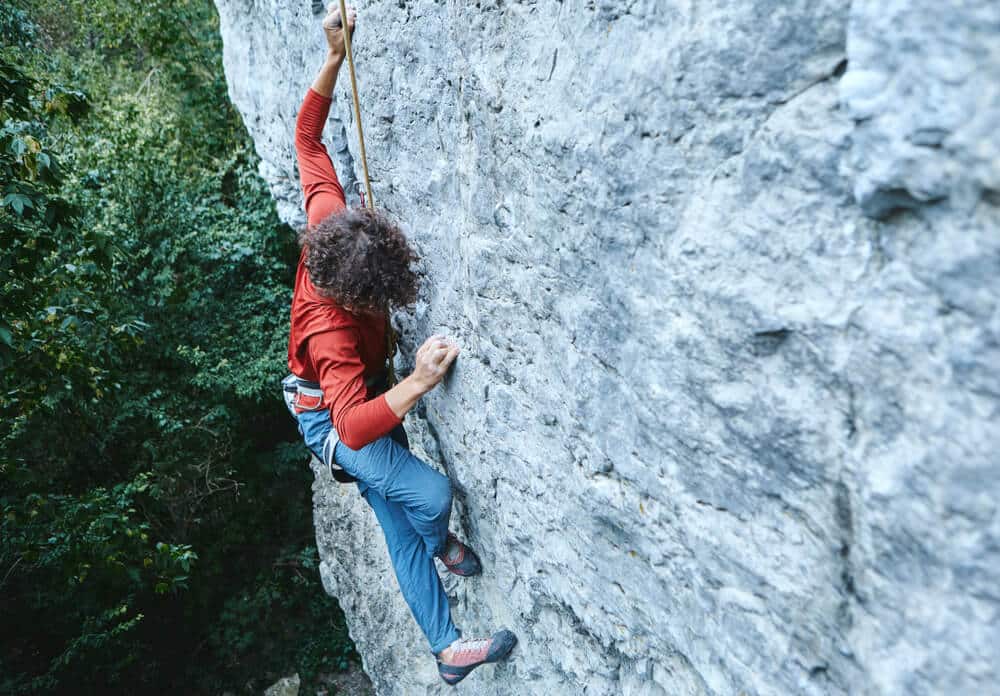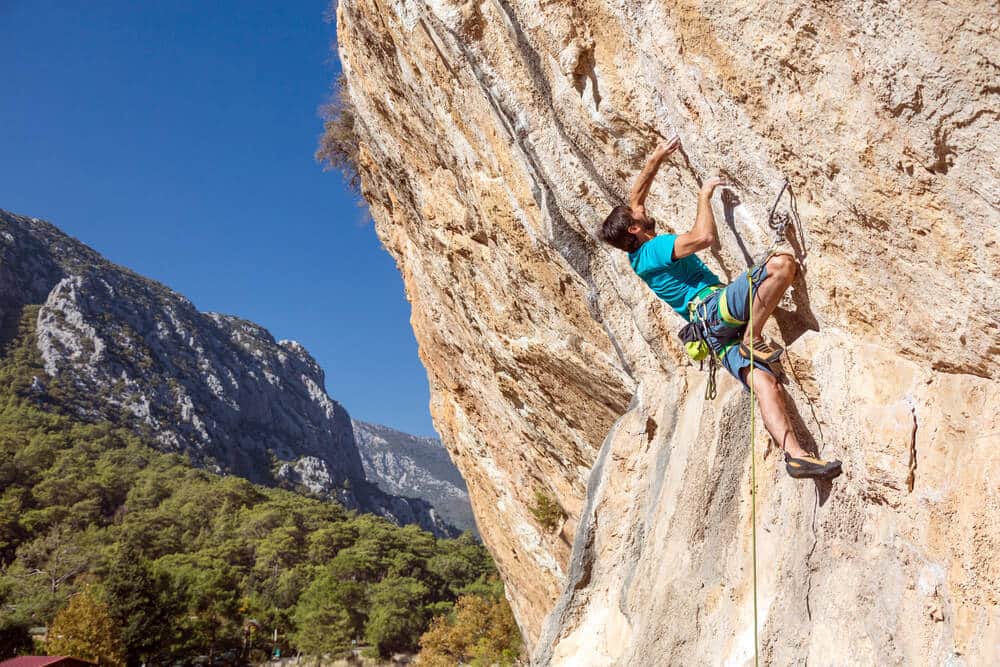When you first start rock climbing, it’s easy to think that the way to climbing excellence is to get massive shoulders and be able to do a one arm pull up. It’s true that it can help to be strong! However, as you progress in the sport, you learn that climbing is often more about technique than it is about brute strength or power.
Flagging is one of these rock climbing techniques that can help you ascend more challenging routes and boulder problems efficiently. Flagging is a footwork technique in which you use one foot as a counter balance to help you maintain your position and be able to perform the next move.
How and when to flag
If you tend to lose balance on the wall, you may need to start flagging! The general principle of flagging is that you have one foot on a foothold, and you extend your other leg out and press your foot against the wall. You’re not stepping on any particular foothold; instead, your flagging leg acts as counter weight for your body.
Flagging can be useful in certain situations where you have only one foothold available. For example, imagine being on the wall with a good right foothold and a good left hand hold. That’s a pretty balanced position, right? However, if both the foothold and handhold are on the left, it’s easy to barn door off the wall as you try to move up.
In this situation, extending your right foot behind your left leg and pressing it against the wall (a rear flag) can help you maintain balance as you make your next move. Having more weight out to your left side will create a more stable position.
Flagging is a beneficial technique because it allows you to maintain body tension while utilizing less energy. Instead of using your muscles to hold yourself on the wall, you can use flagging positions.
Types of flagging
There are two major types of flagging: the front flag (also sometimes called the outside flag) and the rear flag (or back flag). There’s also a less common type of flagging: the inside flag. Let’s review these different techniques and where each of them is used.
The outside flag
The outside flag is a very common technique, and can help you save energy and maintain balance. In this technique, the flagging foot is extended out on its respective side (i.e. the right foot flags out to the right).
Usually, a front flag is performed when the opposite hand and foot are on holds that are in line. To picture this, think about being on the wall with your right hand on a good hand hold and your left foot on a foothold directly below your right hand. You need to reach up and to the left with your left hand.
In this situation, flagging your free leg out can help you make that next reach. This is a scenario in which your body position really matters! Flagging to the right will allow your body to turn to the right and will keep your hips close to the wall, giving you the maximum reach up.
Whenever you flag, it can be helpful to imagine a vertical line running down the center of your torso. To achieve balance, try to balance your body weight on both sides of this line. Utilizing a flagging position can help shift more weight to one side of the line, thus helping you maintain balance.
This is the most common climbing flag, and you’re likely to encounter it very often! Remember to flag your foot on the same side (right foot always flags to the right).
Rear flagging
As noted above, if you have a foot and hand hold on the same side of your body, rear flagging can be very useful. This technique is especially suited for situations where you need to move in the opposite direction from the side of your body that the holds are on.
To rear flag, you extend one leg across and behind the other, and press it into the wall. For example, let’s say your left arm is on a handhold and your left foot is on a foothold. You can take your other foot and extend it out behind the right leg– this can prevent you from barn dooring and allow you to reach the next hold efficiently and move towards the opposite side.
Rear flagging is common on overhanging terrain, and it can help you avoid excessive dynamic movement, which thus helps you save energy. This technique is also sometimes referred to as a back flag.
An important thing to note with back flagging is that it requires a relatively high foothold. The higher your standing leg is, the deeper and more stable your back flag will be. If the foot is too low for a good back flag, try switching your feet and using a front flag instead.
Inside flagging
In inside flagging, the flagging leg crosses underneath the other leg. So, your left foot could be on a foothold, and you would extend your right foot out to the left, in between the wall and the left leg. In doing this, your body will naturally turn to the left.
A situation where you may want to consider inside flagging is when you might be able to use a rear flag, but the foothold is a bit too low. When the foothold is lower down, it gives you more room to step across on the inside of your other leg. If you were to try to use a rear flag in this situation, you might find that your body position would be too low to reach up to the next hold. Inside flagging can keep your center of gravity higher up, which can help you move upwards.
However, in most cases, you can replace an inside flag with a front flag. To do this, you’ll want to swap your feet: instead of inside flagging with the left foot, put the left foot on the foothold, and flag the right foot out. The benefit of this is that it puts less load on the fingers than it would if you were to do an inside flag.
So, when should you use an inside flag? Sometimes, it can be useful to help you establish a starting position on a boulder problem. Some climbers also find that on very steep terrain inside flagging helps keep their center of gravity close to the wall.
There are many climbing techniques to learn, and inside flagging shouldn’t be a priority. Although it can be useful in very specific situations, it’s better to invest your time on learning more commonly used types of flagging.
Tips
Most climbing techniques are complex and nuanced, and flagging is no exception. Here are some tips to consider for the best possible flagging.
-
Leg straight: Keep your flagging leg straight, as this will best help you with maintaining balance.
-
Push into the wall: Make sure to press your flagging foot into the wall. This will give you more stability than simply dangling the foot out.
-
General climbing efficiency: It’s always important to make sure you are climbing with generally good form. Having straight arms and keeping your hips close to the wall will help with conserving energy.
-
Hip position: Body positioning is very important in flagging! It’s a technique that involves your whole body, and an important piece of this is your hips. The position your hips should be in depends on the type of flagging you are doing.
-
When front flagging, your hips can be square to the wall or turned to one side. The correct hip position depends on the specific move you’re doing, but in general turning one hip in is often useful on steeper climbs, as it can help keep your center of gravity closer to the wall. Let’s say that you are performing an outside flag with your left foot. Turning your hips to the left so that your right hip is close to the wall can help you have better balance.
-
When you back flag, you should keep your hips square to the wall.
-
Inside flags always require you to turn your hips towards your flagging foot.
-
Common mistakes
Many people in the climbing world flag incorrectly! Here are a few common mistakes to be aware of.
-
Selecting the wrong flag: An easy mistake to make is front flagging when you should be back flagging, or inside flagging when you should be front flagging. Keep in mind the analogy of the vertical line and consider which type of flagging will best balance your body weight. Remember that the correct flagging position will usually involve extending your leg in the opposite direction from which you are moving.
-
Smearing poorly with your flagging foot: As noted above, you want to make sure you are pushing into the wall with your flagging foot. Many newer climbers forget to push at all, or they do so poorly. To execute this technique well, you’ll need to think about which part of your foot should be in contact with the wall. If you are utilizing a rear flag or inside flag, you’ll want to push with the outside edge of your foot. In contrast, when you’re front flagging you push with the inside edge of your climbing shoe.
-
Not keeping your hips close to the wall: Remember that keeping your hips close to the wall is efficient and allows you to reach further. Many newer climbers don’t keep their hips close enough to the wall when they flag. If you feel like your hips are too far, try changing your hip position of doing a different type of flagging.
Flagging versus back stepping
Many beginner climbers get confused on the difference between flagging and back stepping. A common misconception is that back stepping is similar to back flagging. However, back stepping actually refers to how your foot is placed on the hold: if the outside edge of your shoe (the pinky toe side) is in contact with the hold, this is a back step.
Back stepping involves turning your hips in the direction your toe is pointing. Often, you might combine back stepping with flagging, but they are not the same thing. For example, you might back step with your left foot and flag your opposite foot out to the right as your right arm moves up to the next hold.
Final Thoughts – Get Some Real Practice Flagging!
This article doesn’t replace proper instruction, but it should provide you with some useful knowledge on how to flag. It’s a key rock climbing technique, so practicing it will definitely help elevate your climbing to the next level and unlock new climbing moves.
Flagging is commonly used when there is a lack of good footholds and you’re unable to have two feet on holds. With this technique, you can effectively utilize just one foothold and efficiently move to the next hold.
With all this information in mind, try to incorporate some flagging into your next climbing session! And as you progress in your climbing, make sure to educate yourself on more important techniques. A few to check out include kneebars, smearing, and heel hooks.



















